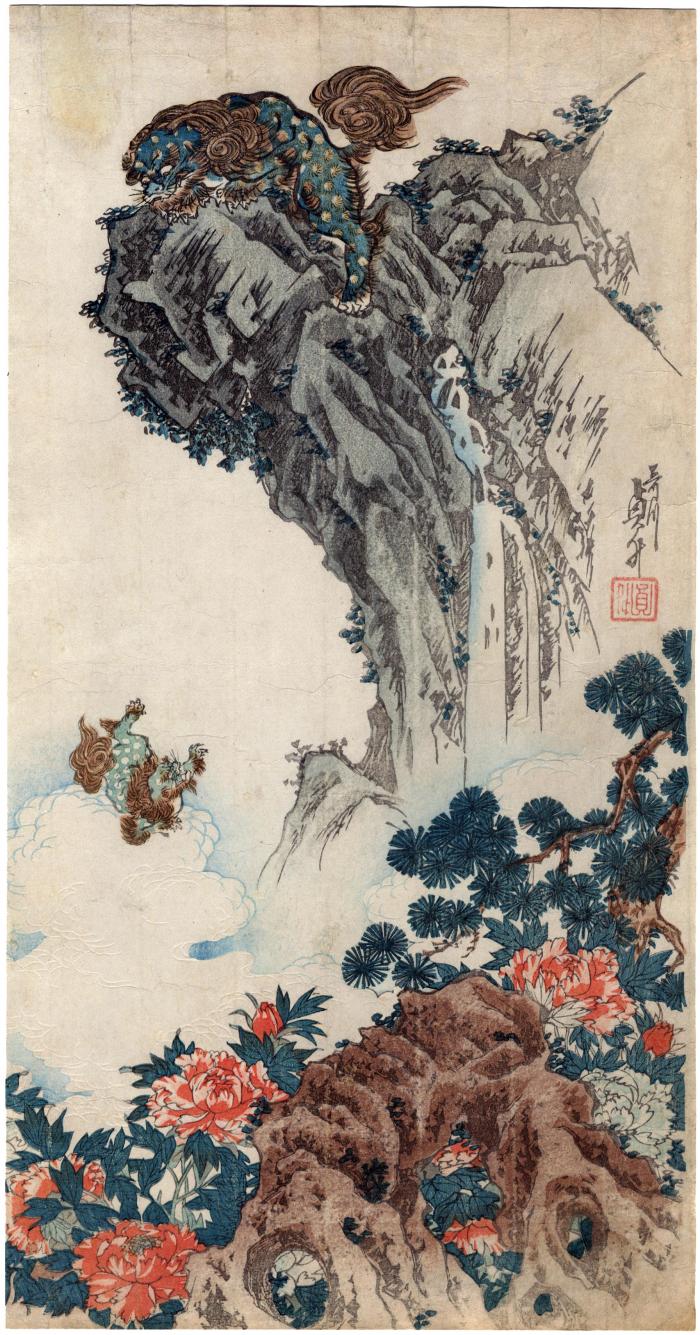Utagawa Sadamasu (歌川貞升) (artist )
Shishi (Lions) near the Stone Bridge near Mt. Tientai
ca 1833 – 1834
8.875 in x 17 in (Overall dimensions) Japanese woodblock print
Signed: Utagawa Sadamasu (歌川貞升)
Artist's seal: Sadamasu
Royal Ontario Museum - similar Utamaro print Of the 1779 painting of 'Lions at the Stone Bridge of Mount Tiantai' by Soga Shōhaku, a masterpiece of wit and skill, the curatorial files say: "In this fantastical scene at the natural stone bridge on Mount Tiantai, in China’s Zhejiang province, a mother lion throws cubs over the cliff to see which will persevere to succeed in life by climbing back to her. Analogies are often made to artists or teachers testing pupils in similar ways. Mount Tiantai, home to the Tiantai sect of Buddhism, is also a sacred site for Daoist practice. In China as in Japan, mountains were long regarded as intermediary places between heaven and earth, where immortals and humans could meet."
****
This is the right third of a large (17 x 23 in) surimono. The left two thirds include poems by Kataoka Nizaemon VII and others. According to Huys den Esch this act of a parent lion throwing its cub off a cliff into a free-fall in a ravine is tantamount to an actor presenting its child into a theater under a new stage name. "This print much resembles an unsigned surimono that was published in 1788 to celebrate the actor Asao Kunigorō II’s change of name to become Kataoka Nizaemon VII. More than forty years later, the actor, by then the leading star of the Kataoka line, commissioned Sadamasu to design a new version. The subject matter of Sadamasu’s surimono most likely concerns a special event in the career of either Shimamaru or Gatō. The first started a career as an actor in the 1810s and was as a troupe leader at two theatres in 1828 and 1829. The last started acting in 1831 and, after the young actor had become a disciple of Nizaemon VII, he took the name Gatō in the spring of 1833."
The missing poems are by Arashi Rikan II, Shimamaru (the son of Kataoka Nizaemon VII), Gatō (i.e. Kataoka Gadō II) and Kataoka Nizaemon VII.
****
Legend states that shishi (a mythical animal which resembles a lion and which guards Buddhist temples) test the vitality of their cubs by throwing them from the cliff. The shishi is often associated with peony flowers such as in the kabuki play, Shakkyō (石橋).
****
Maude Rex Allen wrote in 1917 in Japanese Art Motives on page 29: "The peony was brought to Japan in the eighth century from China, where it is one of the plants of the four seasons - the flower of summer. As an art motive, Japan is indebted to Korea for the wonderful variety of adaptation in showing this gorgeous flower."
"Because of the size and beauty of its crimson blossoms, the peony is an emblem of regal power. It is associated with the kara-shishi or Chinese lion - the king of beasts and the king of flowers. Another interpretation of this combination is given:"
In art, the peony is represented among the rocks with kara-shishi, a Chinese association, known as the botanni-kara-shishi, which may illustrate the theory of the survival of the fittest, for it is said that of the cubs which fall to the ground amongst the bushes of the peony, only the strongest succeed in rejoining their mother by climbing the rocks and thus attaining maturity." Allen is citing J. L. Bowes's book, Japanese Pottery on page 495.
****
Illustrated in Utagawa Sadamasu: Distinguished Osaka Print Artist by Jan van Doesburg, page 63, 2012.
surimono - 摺物 (genre)
Kataoka Nizaemon VII (七代目片岡仁左衛門: 2/1788 to 3/1837) (actor)
